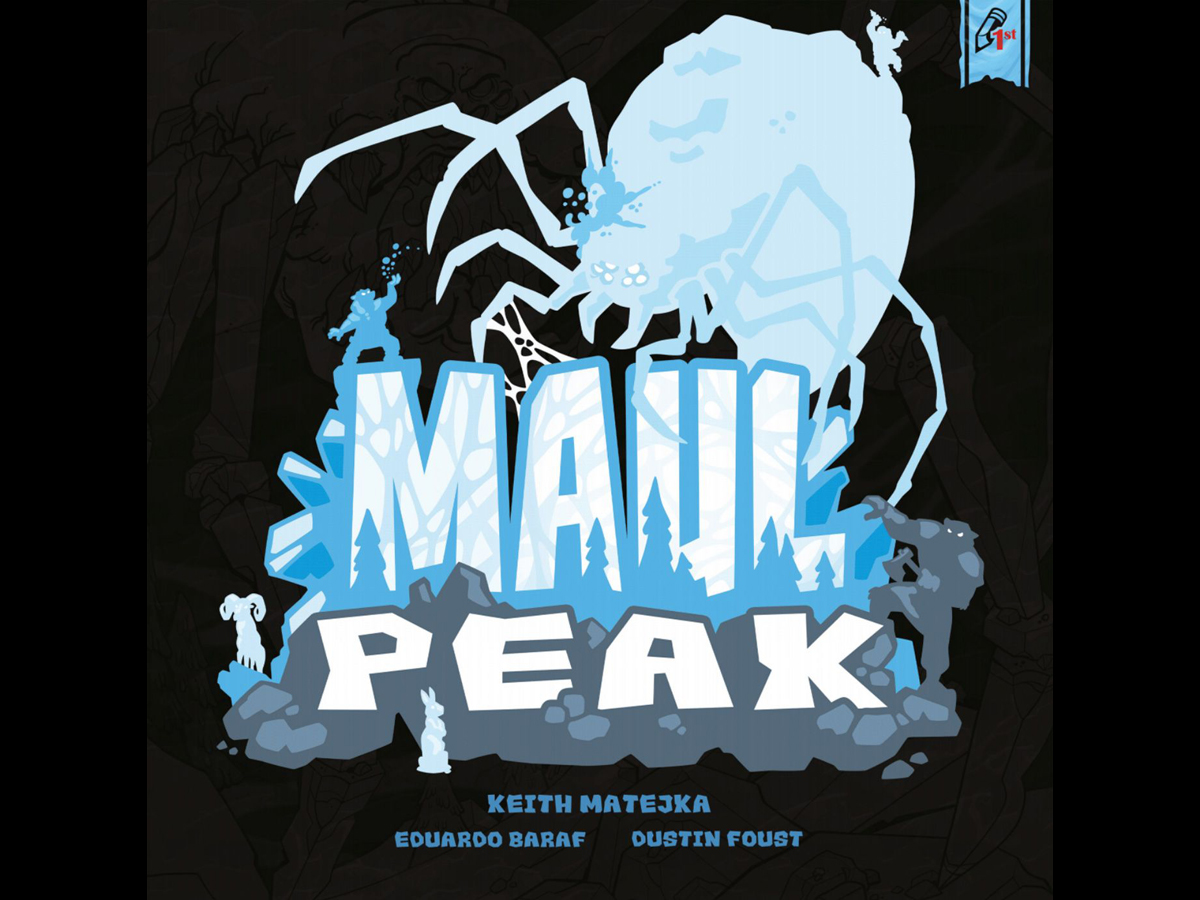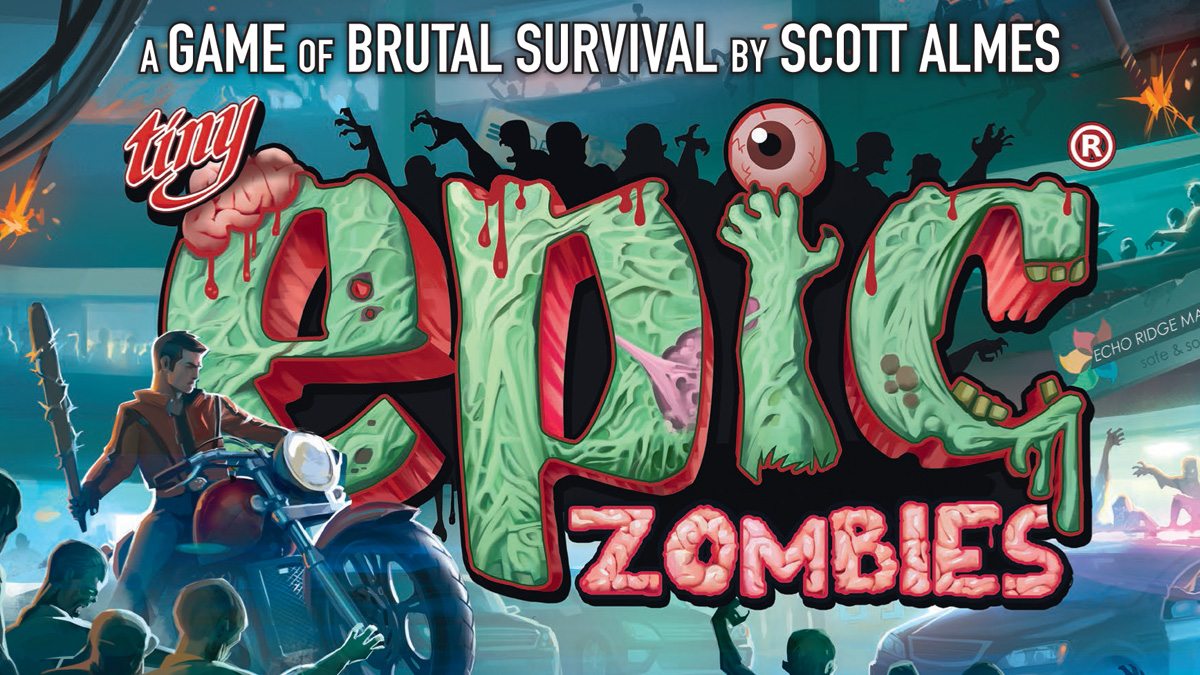Now it’s the Grizzar’s turn to face the giant guardians, in the cold western mountains.
What Is Maul Peak?
Maul Peak is an asymmetric battle game for 2 players, ages 12 and up, and takes about 30 minutes to play. It’s currently seeking funding on Kickstarter, with a pledge level of $45 for a copy of the game (which will also include the Runes & Ruins solo adventure and Ancient Relics Mini-Expansion). Maul Peak is a follow-up to Skulk Hollow; each game stands alone on its own, but you can also mix and match between the two games, or combine them for a 3- or 4-player variant. As with Skulk Hollow, the game involves battling in a fantasy setting; the rules aren’t too difficult to grasp for kids, and the difficulty of the game will just be driven by the skill level of the two players.
Maul Peak was designed by Keith Matejka and Eduardo Baraf and is published by Pencil First Games, with illustrations by Dustin Foust and meeple design by Helen Zhu.
New to Kickstarter? Check out our crowdfunding primer.

Maul Peak Components
Note: My review is based on a prototype copy, so it is subject to change and may not reflect final component quality, though in this case the prototype is close to complete. Some of the exact text and powers have changed due to balancing, but the components themselves will be pretty similar. The exact number of tokens may be adjusted slightly as well.
Here’s what comes in the box:
- Maul Peak map
- 15 Rage cubes (red)
- 12 Power cubes (yellow)
- 25 Wound tokens (blue and red)
- 6 Ancient Relic tokens
- Grizzar components:
- Grizzar player mat
- 6 Grizzar Hero meeples
- Winter Beast meeple
- Grizzar Den mat
- Grizzar deck
- Guardian components:
- Saboso: board, player mat, deck, Saboso meeple, 5 shiver tokens
- Veblyn: board, player mat, deck, Veblyn meeple, 10 web tokens
- Quagra: board, player mat, deck, Quagra meeple
- Trovak & Gnarl: board, player mat, deck, Trovak meeple, Gnarl meeple
Grizzar and guardian components each have their own little tuckbox, too, so they’re easily sorted.
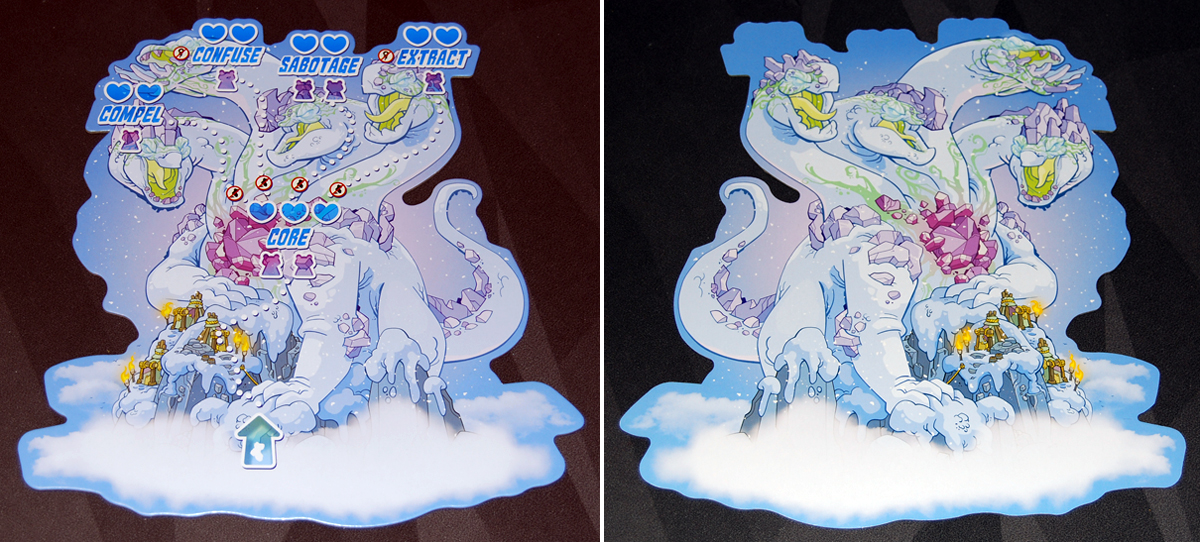
The map is a square board, about the size of the game box, with a 3×3 grid. It’s illustrated as a top-down view, showing the Grizzar village keep in one corner and the guardian lair—which looks like a stone bear head—in the opposite corner. Each of the guardians has its own board, a map-sized cut-out of the guardian itself, with various locations marked and paths between them, representing the ways that the Grizzar can leap up onto the guardian itself to do battle. I really love the illustrations Dustin Foust made for these: the monsters are made of snow and ice and crystals and are really impressive. The backs of the boards have the illustrations without the paths and text so you can really admire the artwork.

Speaking of illustrations, the Grizzar heroes are also vibrant and colorful, and they look like they belong in a comic book or an animated show. Even the icons for the various actions on the cards have the same style. Based on some feedback, Pencil First Games worked with both Shelf Stories Consulting and Pe Metawe Consulting and made some changes to ensure the game was respectful to indigenous cultures. I appreciated the thoughtful approach they took, and I hope that more publishers and designers continue to involve cultural consultants early in their design process.
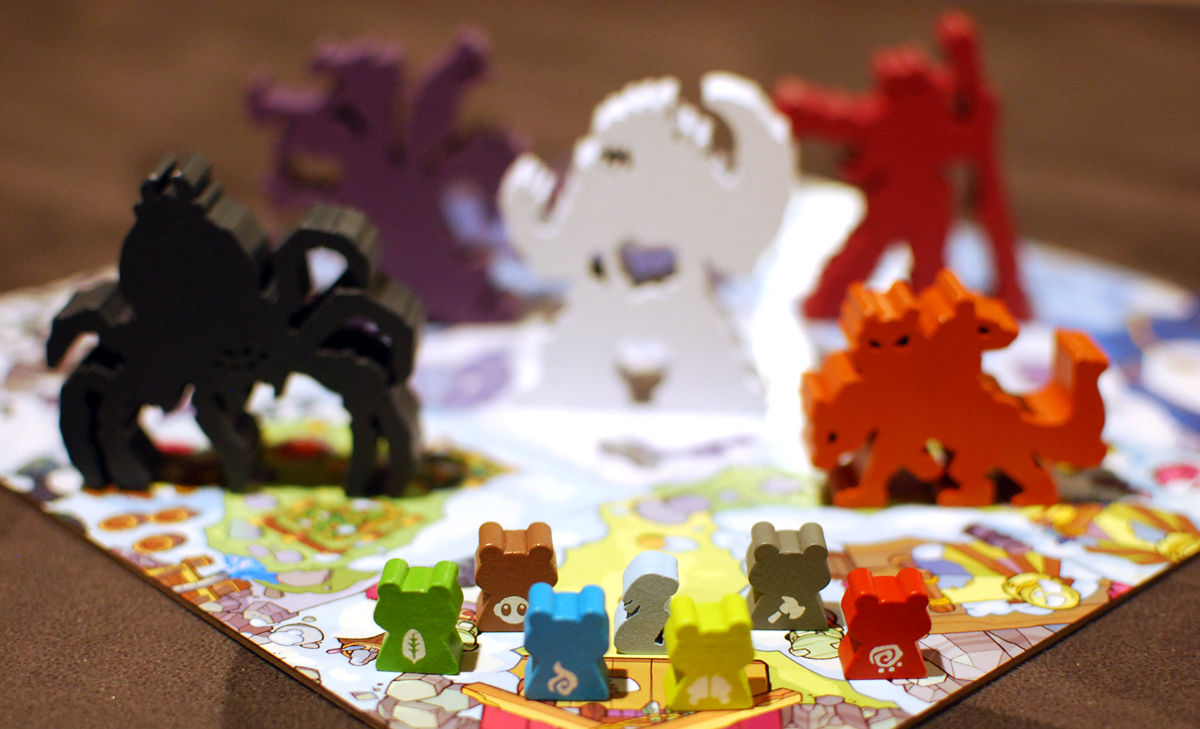
The meeples, designed by Helen Zhu, are really impressive. The small bears are all the same shape but are distinguished by color and little icons that help match them up with the corresponding card. Although there are different winter beasts to choose from, it’s represented by a sort of ghost-creature meeple. The guardians have huge, oversized meeples that help give a sense of the David-and-Goliath scale of the game, as they tower over the bears. Each of the guardians has its own tuckbox for its components and the meeples take up a substantial portion of the boxes.
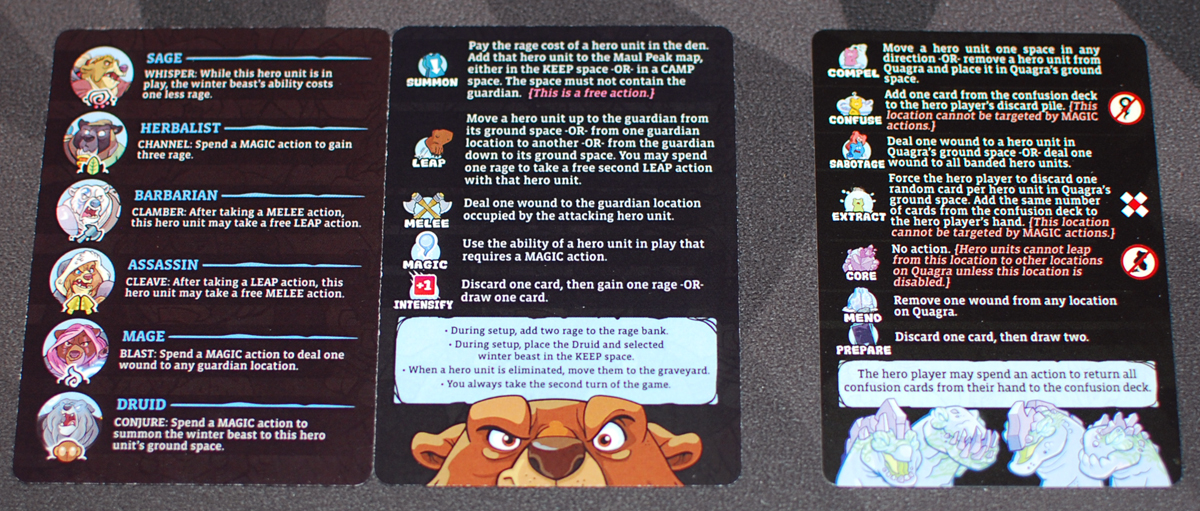
There’s a lot of text on the player mats detailing how each character’s powers work. I like the fact that each character has small reference cards that you pass to the other player so they can see what you’re capable of. The Grizzar has a bunch of these: a card explaining each of the Grizzar heroes, cards for the various winter beasts that could be used, and a card for the general Grizzar player actions. My only complaint is that the text on the reference cards is pretty tiny, so if you use reading glasses you’re definitely going to need them here.
The den board is a board that holds 5 Grizzar hero cards until they’re summoned, and also has a graveyard space for when they’re defeated. It’s nicely illustrated but doesn’t really feel necessary for storing 5 cards plus a sort of discard pile.
How to Play Maul Peak
You can download a copy of the rulebook here.
The Goal
The Grizzar player wins by eliminating the guardian, filling all the wound spaces on the guardian board. The guardian player can with either by eliminating all Grizzar units in play, or with the guardian’s specific win condition.
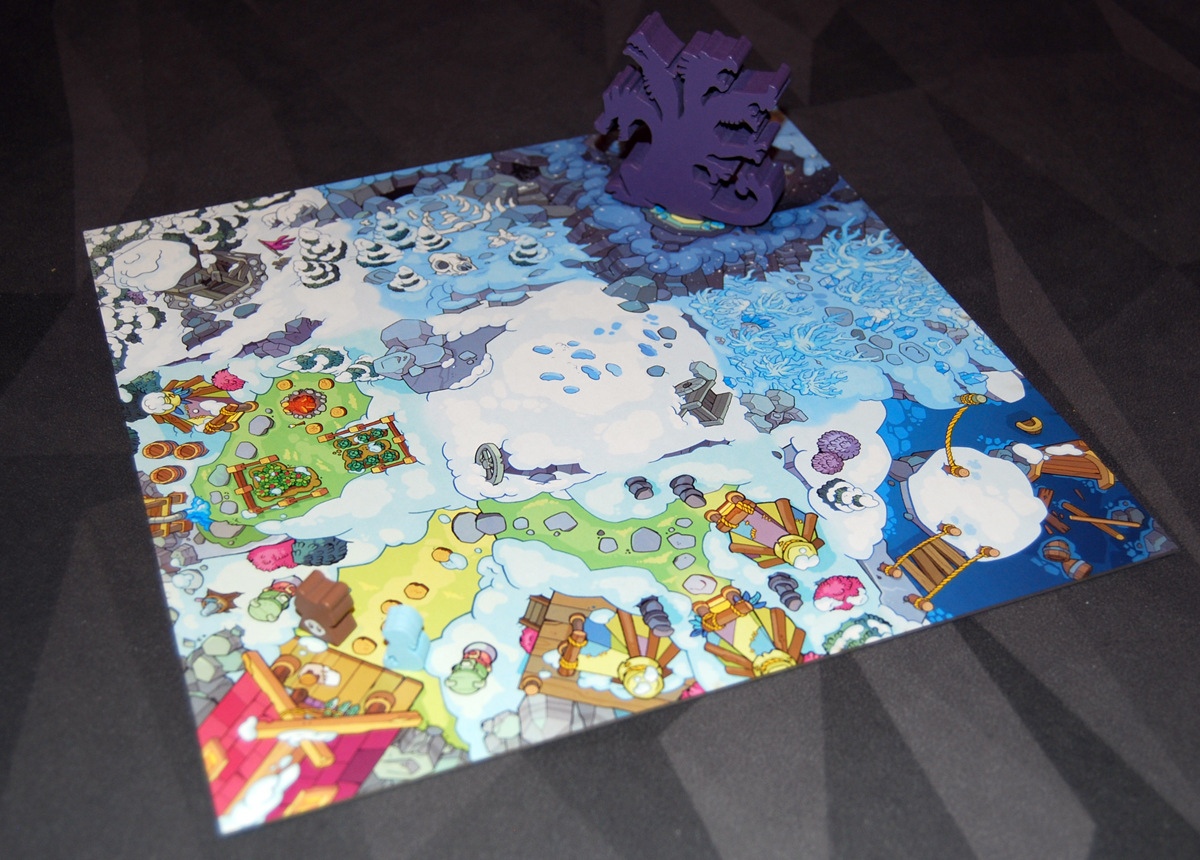
Setup
Place the Maul Peak map between the two players, set diagonally so that the village corner points toward the Grizzar player and the lair points toward the guardian player. Make a supply of the tokens: wounds, power cubes, and rage cubes.
The guardian player selects a guardian and gets all the guardian-specific components; some guardians have additional setup instructions printed on their mats. The guardian meeple starts on the lair space. Place the guardian board next to the map.

The Grizzar player takes all their components and selects a winter beast card to use. Place the Druid card and the selected winter beast in play next to the player mat, and the rest of the Grizzar heroes on the den board. The Druid and winter beast meeples start in play on the keep, and the rest of the meeples are set nearby for now. The Grizzar player gets 2 rage cubes placed in the pool on their player mat.
Each player shuffles their own deck of order cards, and draws up to their hand size (shown on their player mats). The guardian takes the first turn.
(The ancient relic tokens can be used to handicap the game for less experienced players—give them some number of tokens at setup, and each one may be spent once during the game for an extra action.)
Gameplay
On your turn, you take actions, and then do a cleanup phase.

Each player has a number of actions shown on their player board (e.g., the Grizzar player gets 3 actions). The Grizzar player has a special action called Intensify: discard a card, and then either draw a card or gain 1 rage. Rage can be spent from your bank for two effects that don’t require using your actions: you can summon additional heroes to the board, or use your winter beast’s power. Also, whenever a Grizzar uses a leap action, they can spend rage for a free additional leap.
The Grizzar deck consists of order cards, used to let your various units take actions. Most cards have two actions pictured—when you play an order, you get to choose one of the actions. You will use actions to move around on the map, gain rage cubes (to your pool), leap onto the Guardian, perform melee attacks, and use magic. Some of the Grizzar heroes have a magic ability—for instance, the Druid can use it to summon the winter beast to its location, and the Mage can use it for a ranged attack.
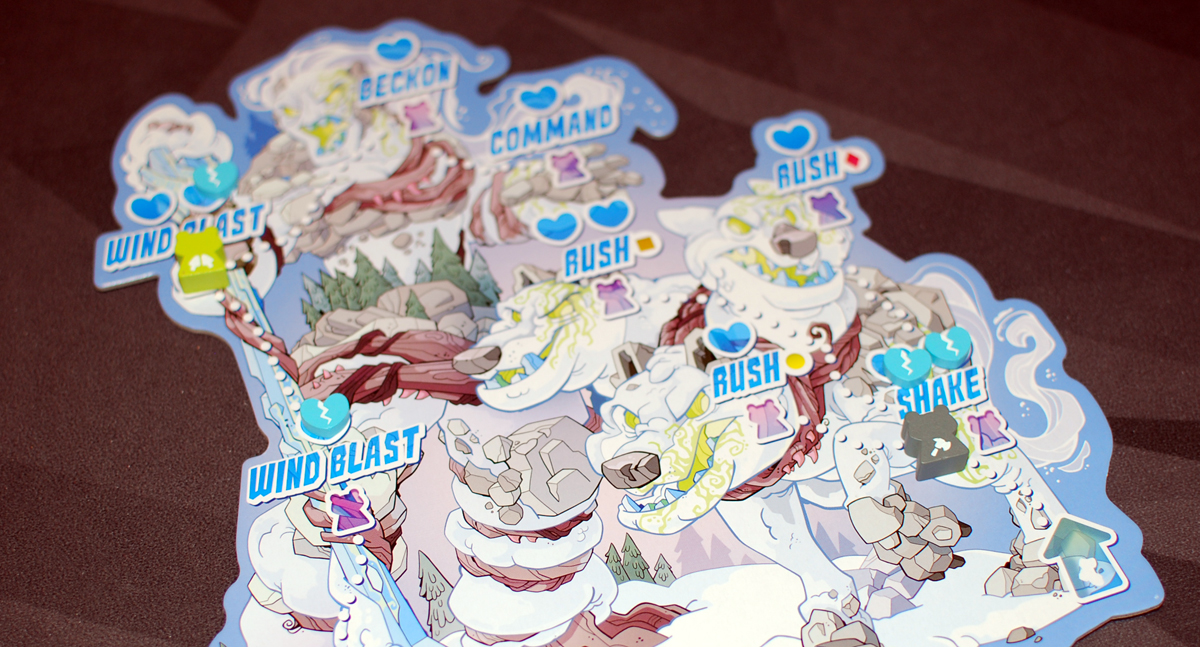
When you leap, you may either jump from the ground onto the guardian board (if you’re in the same space on the map), or else move from one space on the guardian board along the path to another spot. Each location has icons showing how many units may be present there, and how much health that location has before it is disabled. Melee attacks strike the guardian at a location where your unit is present. Unlike the Foxen heroes of Skulk Hollow, there is no “ranged attack” action in the Grizzar deck. Not every unit has access to every type of action—these are indicated on the unit cards.
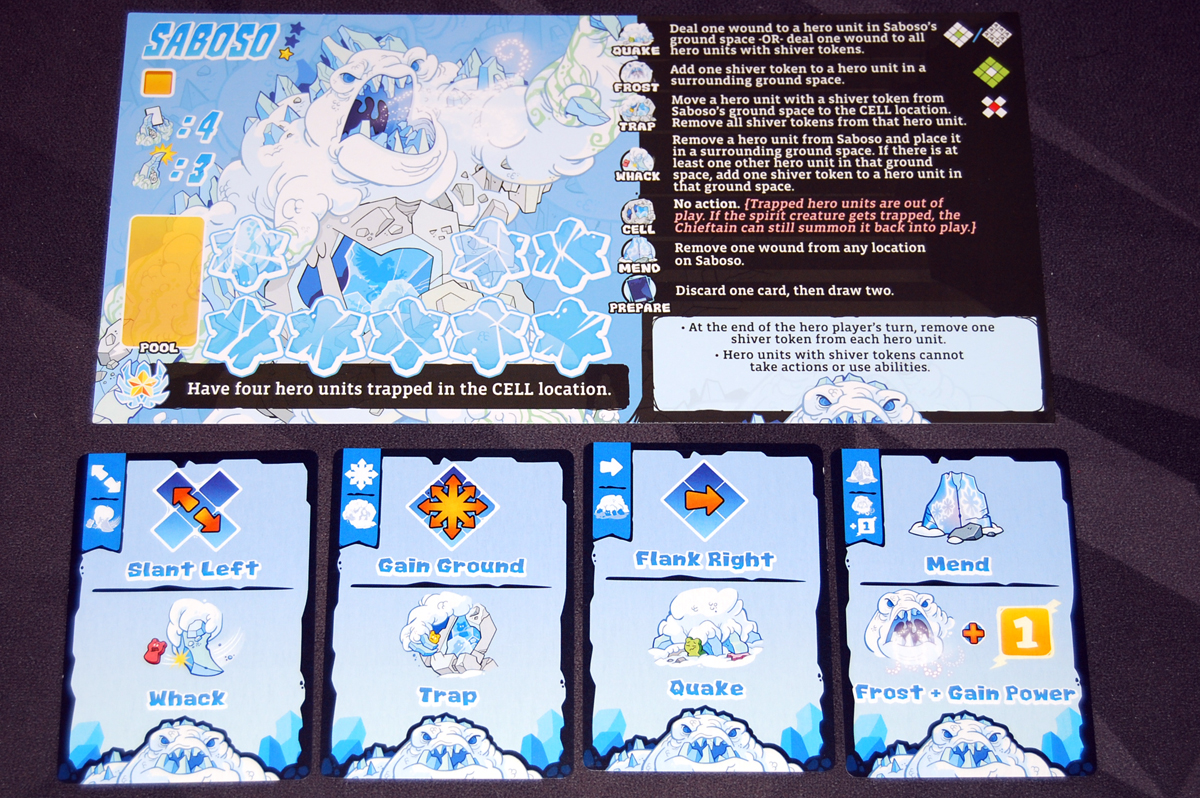
The guardian player, as in Skulk Hollow, may use actions to play cards or to Prepare: discard a card to draw 2 cards. The guardian’s action cards also include movement on the map board and various types of attacks and actions. Most cards include two actions to choose from, and the list of actions varies based on the guardian. Each Guardian has “mend” to heal wounds on the Guardian board, as well as ways to attack units on the ground, and either attack or remove units on the guardian board.
In order to use an action, the associated location on the guardian board must be active—if it has been filled up with wound tokens, then that ability has no effect until the guardian has used mend to heal at least one wound from that space. Some spaces may have additional effects when wounded—for instance, Veblyn’s hand size is affected by how many “skitter” spaces have been wounded.
At the end of the turn, the Grizzar player moves all collected rage cubes from the pool to the bank, and the guardian player may allocate any power cubes that they acquired this turn onto available spaces on the guardian board (discarding any excess), and then draw cards. If you have fewer than your hand size, you refill your hand. If your hand is already full (or more than full), you draw one card.
Game End
The game ends immediately when either player hits their victory condition. The Grizzar player wins if all of the locations on the guardian board are disabled. The guardian player wins if it eliminates all of the Grizzar units in play, or achieves its specific goal:
- Saboso: have 4 hero units trapped in its cell
- Veblyn: have 3 hero units in the lair space
- Quagra: deplete the entire confusion deck
- Trovak & Gnarl: fill the power track with 9 spent power cubes
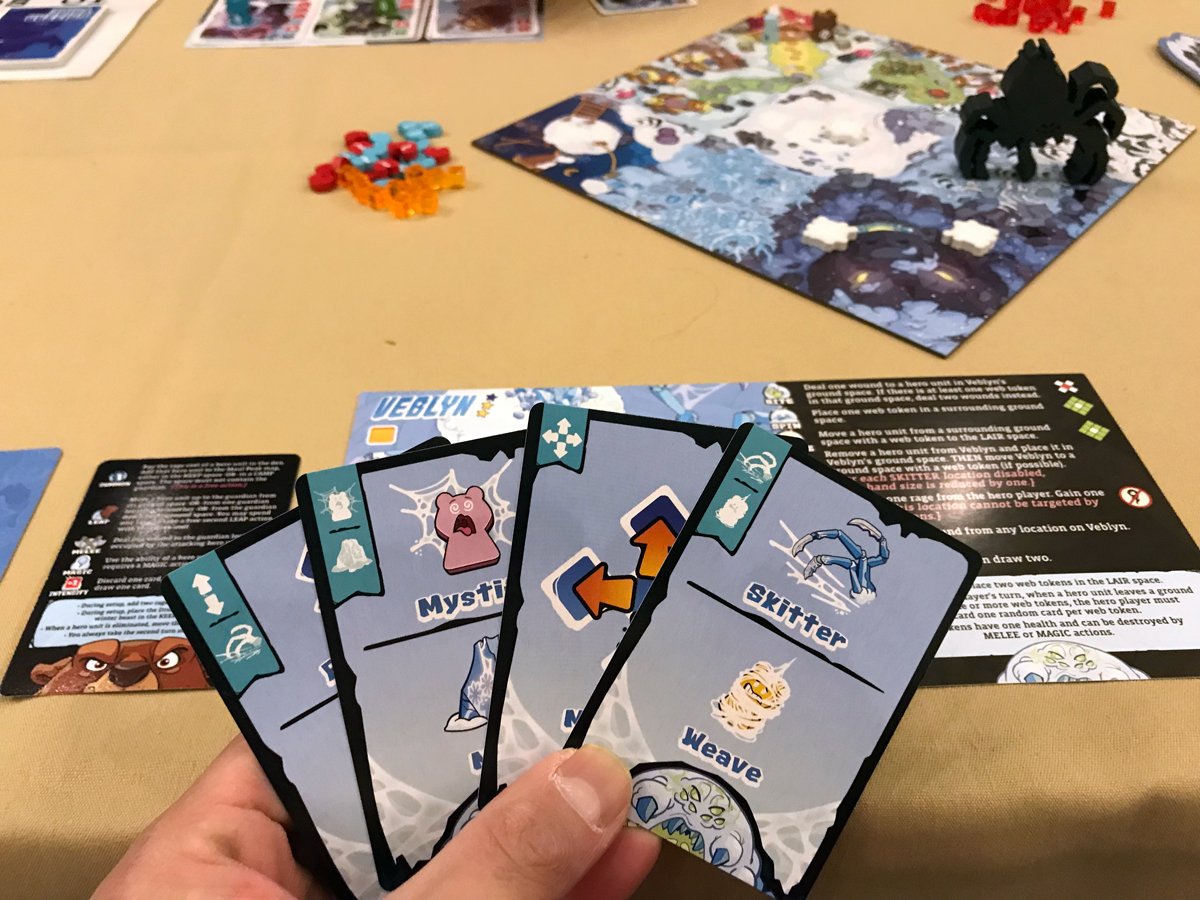
Why You Should Play Maul Peak
I first reviewed Skulk Hollow a few years ago when it was on Kickstarter (with a follow-up posted last week), and was really charmed by the concept: I like that the guardian is so huge that its body is literally a map that the smallfolk need to traverse. The artwork by Dustin Foust really brings the setting to life, and each guardian has unique abilities that require different tactics to counter. Maul Peak brings you to a different corner of this world, where the Grizzar bears make their home in the snow-covered mountains to the west.
While the core gameplay is the same as Skulk Hollow, the Grizzar team plays quite differently from the Foxen. For one, the Grizzar heroes are not shuffled into the deck—instead, they can be summoned using rage cubes, but only once per character. (The Foxen heroes are discarded and may be played again when you draw them again.) That means, instead of having an unlimited army to throw at your opponent, you need to budget your troops. In Skulk Hollow, the guardian only needed to eliminate the noble to win—but the noble was protected by any heroes in the same space. In Maul Peak, the Druid is your starting hero but has no special protection; however, the guardian doesn’t automatically win by defeating the Druid, but by eliminating all of the heroes who are present.
The Grizzar also don’t have access to the “prepare” action to draw cards more rapidly, but instead gain rage that can be spent for some specific actions. In particular, your winter beast’s power relies on rage, so choosing the right winter beast based on the guardian you’re battling can be an important decision. It did feel like the Grizzar had a bit more of a learning curve than the Foxen, because it’s a little harder to dig through your deck looking for particular actions. I like having another set of smallfolk, though: since each game has 4 guardians to choose from, there was already a lot of variety on that side, and this gives some more variety for the smallfolk teams.
The new guardians have a mix of new abilities. Saboso adds shiver tokens to heroes, and can then trap those heroes in its cell, a location on its board. Veblyn spins spider webs that heroes must attack so they don’t lose cards, and then yanks heroes into the lair using the webs. The many-headed Quagra can add confusion cards to the Grizzar deck, taking up precious hand space with cards that do nothing. Trovak and Gnarl are a team of two, coordinating attacks and movement to bounce heroes back and forth.
As I’ve said previously, I don’t generally play as many 2-player-only games, so these types of games don’t hit the table quite as much for me, but Maul Peak plays pretty quickly so it’s easy to play a couple rounds in one sitting. You can have a battle, and then trade sides so each player can get a feel for both the smallfolk and the guardian. I haven’t yet had a chance to try the combined game, but you can set up the board with both teams of smallfolk and two guardians for a huge showdown, or you can also mix-and-match to pit Foxen heroes against the snowy Maul Peak guardians or the Grizzar heroes against the Skulk Hollow guardians. I’m excited about exploring both the new guardians and the new smallfolk, along with the option to expand the game to 3 or 4 players.
For more information or to make a pledge, visit the Maul Peak Kickstarter page!
Click here to see all our tabletop game reviews.
![]() To subscribe to GeekDad’s tabletop gaming coverage, please copy this link and add it to your RSS reader.
To subscribe to GeekDad’s tabletop gaming coverage, please copy this link and add it to your RSS reader.
Disclosure: GeekDad received a prototype of this game for review purposes.
